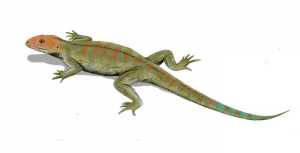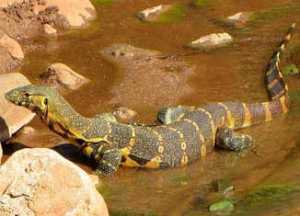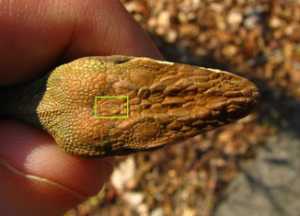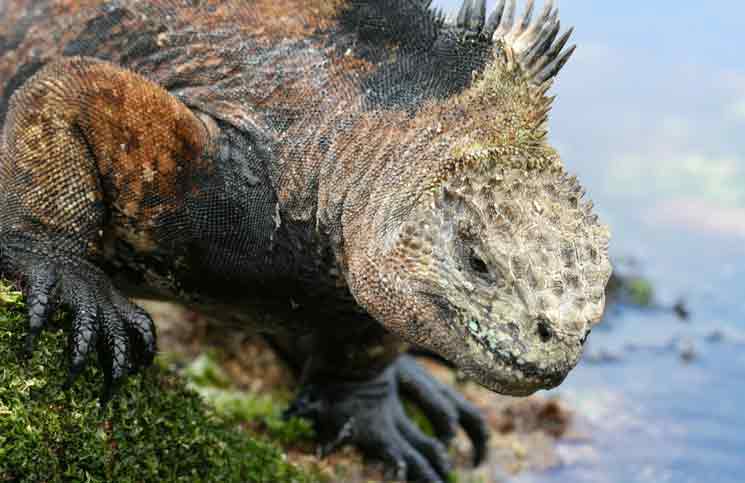CAN LIZARDS SWIM IN THE OCEAN? WHAT IS THEIR THIRD EYE? HOW DO THEY COMMUNICATE? Those questions and much more, below…
I guess you are also curious about this amazingly cute group of reptiles, or maybe you’re just doing your homework on Lizards. No matter what the case is, you’ve reached the most comprehensive page on the net featuring gripping Lizard Facts…
Let’s start from the bottom with the most basic lizard facts, and slowly move up the ladder to the more fascinating stuff about these wonderful creatures.
BASIC LIZARD FACTS…
• How ancient are Lizards? Well, they are extremely old, dating back millions of years into the era of dinosaurs. In 2013, a group of researchers in Mexico discovered the remains of a 23-million year old lizard fossil, which is most probably a new species belonging to the genus Anolis. However, that’s not all. Other fossil tracks findings dating back 315 million years revealed imprints of scales and toes attributed to the Hylonomus. This ancient lizard-like creature is the oldest reptile known to man, and it definitely looks like a lizard. Don’t you think?

• Where Do Lizards Live? One of the most obvious lizard facts is that lizards are the most common reptile on the planet. In most cases we can even find one or two living in our own house! However, most lizards live on the ground or in trees, while other species might be found in deserts, rain-forests, rivers, streams, or even in subterranean burrows.
• Need the technical stuff? I personally never search for these technical lizard facts and phrases, but sometimes it’s required. So for your information, Lizards are recognized as the suborder of reptiles called Lacertilia. The Lacertilia includes another four suborders called Iguania, Gekkota, Amphisbaenia and Autarchoglossa.
• Are Lizards cold blooded? Indeed they are, like most other reptiles. Every different species of lizard has its optimal range of body temperature. In its optimal temperature range, the lizard can operate perfectly, be it run, jump, hunt, eat or mate. However, when its body temperature drops below the optimal range, the lizard will slow down, rest and might not be able to move at all.
• How do Lizards regulate their body temperature? Well, they use two simple and natural techniques to warm up: They sunbathe and absorb the hot sun rays, and they sit on hot grounds to absorb the heat from the ground. If a Lizard is already too hot, it will just hop away from the sun or hot grounds and find some shade and cool soil.
• Do You Know The Lizard’s Body Parts? Almost all Lizards have dry scaly skin, four legs and clawed feet, external ears, and of course a long tail, which many species can detach when in danger (but on that I’ll tell you later). Lizards also have small teeth both on the upper and lower jaws, with which they crush and chew, before they swallow. The eyes of most lizards are very similar to ours, immobile with eyelids for protection and moist. They have excellent vision, including color vision. However, one member of the lizard family has extraordinary vision, and this definitely makes it to one of my favorite mind-boggling lizard facts: It is the fabulous Chameleon, who is actually the only animal on the planet that can simultaneously move and point his eyes in different directions. This enables him to keep a unique narrow field of vision, as well as capture two images at once. Isn’t that amazing? I’m sure you agree with me it is, but it’s not all. Lizards use their excellent vision for more than just see…
• How Do Lizards Communicate? Well, lizards communicate in many various ways, including means of vocal, chemical, tactile and visual communication. They even do push-ups as signal to others. So how do they use their vision to communicate? Well this answer also belongs to one of my favorite lizard facts: They use their excellent eyes to observe physical and behavioral actions and movements of other lizards, similar to us using body language. Most lizards use body language to communicate, and this includes specific postures, gestures and color changing that define territory or settle various disputes. But what happens when a dispute is not settled, how does the lizard escape? I’ll provide the answer after you watch this great clip compiled by the Zoology Department of La Trobe University in Victoria, Australia:
• How Do Lizards Move? Some lizards will move hilariously, raising their body and running on their hind legs, like a pre-historic T-Rex. Other unique lizards can swim and even run on water, but most lizards run on the ground, climb trees or walls, and cling. How do they cling? Well, some species have microscopic hooks that grip irregularities in the surface, while others have millions of microscopic hairs on the bottoms of their tiny feet. Each hair’s tip has special features that function as a dry adhesive. On the other end of the spectrum, there are also lizards that have no legs at all.
Lately, scientists from the University of California discovered that the ability of Geckos to adhere and stick to surfaces does not require muscle activity. They do not need to push their feet and toes onto the surface in order to increase the adhesion. How did they test this? Very simply, scientists tested dead Geckos and saw that they stick exactly the same as living Geckos.
• Are There Really Lizards with No Legs? Several types of lizards live their entire lives with weak useless legs, while others do not have legs at all. The common name for this group of lizards is Pygopodidae, and they actually lost their legs over time, because their limbs were just non-functional in their movement. One famous species of legless lizards is the Glass Lizard, which is known for its fragile tail that can break into many tiny pieces, like glass…So before they break, how do they multiply?
HOW DO LIZARDS SMELL? WHAT DO THEY EAT? HOW LONG DO THEY GET? MORE LIZARD FACTS…
• How Do Lizards Reproduce? Among the small and medium species, Lizards are ready to mate already after 1 year since their birth. For the bigger lizards it might start at the age of 2 or 3. Some species will lay eggs while others give birth to live young lizards. There are very few lizard species, such as the lady Whiptail lizards (Aspidoscelis genus) from Mexico and Southeast U.S, that go through asexual reproductions, meaning: They do not require a mate and manage to produce a well-bred offspring without male fertilization. Quite amazing, it’s another one of these lizard facts that will stay with you when you have that next reptile conversation, isn’t it?
Watch this short clip about the mind-blowing Mexican Whiptail Lizard:
• How is Blue Key For Love Among Fence lizards? According to latest studies, Female Eastern Fence lizards find the blue patches on the undersides of the male Fence lizard as sexy, while the male Fence lizard is actually turned off by blue females. Read our post on the Eastern Fence Lizard Study.
• What Happens to Baby Lizards? After laying their eggs, many lizard species just abandon them to survive by their own. However, Skinks and Glass lizards (the ones without the legs!) protect and guard their eggs from hungry predators, and remain beside their future offsprings until they hatch. When they pop out of the eggs, they instantly go on the hunt for food…
• How Do Lizards Smell? In a similar fashion to snakes, lizards smell by ‘tasting’ the air particles around them. They actually flutter the underside of their throats in order move air through their Jacobson’s organ, absorbing the particles, and smelling. By that they can spot their next meal…
• What Do Lizards Eat? Well, it varies of course depending on the species, but most of the small lizards will eat insects and spiders. Others are herbivors and will eat plants, while some are omnivores, like the Spiny lizard that will eat both plants and small animals. The larger lizards, like the Gila Monster, are carnivores, and will even eat other lizards.
• How long do Lizards get? The length of lizards varies according to their species of course. However, lengths can range from just a few centimeters (or inches) for the smallest chameleon, the Brookesia micra, to 3-6 inches (9-15 cm) for the Common house Gecko. The large lizards, like the Komodo Dragon, can reach lengths of nearly 3 m (9.8 feet), while the Giant monitor Lizard is said to have reached lengths of 7 m (23 feet)! So don’t you mess with lizards…but if you do, try not to step on their tails…

• Are Lizards Dangerous to Humans? Almost all lizards are completely harmless. Only several species of larger lizards, such as the Gila Monster, the Beaded Lizard and of course the Komodo Dragon can definitely attack and harm humans. On the other side of the spectrum, there and dozens of lizards that are regarded as the perfect pets. These include iguanas, chameleons, geckos, anoles and bearded dragons. Many lizards truly learn to like humans, while others remain weary and suspicious. However, if you feed them right with the live crickets and worms they love, they’ll thank you with a smile!
Watch this National Geographic video of the notorious Gila Monster…
• Are Humans Dangerous to Lizards? Indeed they are. Lizards are eaten by humans, at least in some remote places on the planet. In North Africa for example, spiny-tailed lizards are eaten by tribes and regarded as ‘fish of the desert’. In Central America there are tribes that eat Green Iguanas and call them ‘chicken of the tree’. In other counties lizards are hunted and killed for their skins, which are later made into luxury bags and wallets.
• The Predators: Who Else Eats Lizards? Unfortunately for them, these cute creatures are eaten by many various predators, such as raptors and birds, snakes, different types of mammals, as well as by other lizards.
Ready for Weird Lizard Facts? Keep reading…
• Can Lizards squirt Blood From Their Eyes? It may sound a bit crazy or disgusting, but it’s true, and it surely belongs to our list of most incredible lizard facts. There are some types of Horned lizards that when threatened—can scare and confuse predators by squirting blood from their eyes. They can actually aim quite well and even reach four feet. The blood has an awful odor and scares off many of the lizard’s enemies.
• Lizars with a Third Eye? Very few lizards, such as the Green Iguana have a third eye situated on the top of their head. This unique third eye helps them determine if there’s enough light to bask in the sun.

• Eyelids or No Eyelids? Most lizards have some sort of eyelid. But some, like the gecko, don’t have eyelids in the way we know it. They have instead a clear membrane that keeps the dirt out.
• Fastest Tongue? Chameleons have long tongues which they extend in lightning speed! Even too fast for human eyes to see properly.
• How do Lizards conserve water? When there’s a shortage of water in their habitat, Lizards will discharge salt in order to conserve water. This process will usually leave some white residue on their body.
• Can Lizards make sounds? The lucky Gecko is the only Lizard with vocal cords, making him the only one that can truly make sounds.
According to Stefan Pullitzky who lives in Thailand and has many Geckos, including Tokais – all of his Geckos, even the smaller species communicate by voice. “The smaller ones sound sometimes like humans and make a short kiss noise. The small Geckos do it 3-5 times in order. Some of them even make a funny noise like a scolding budie or lovebird. In the same time they wag with the tail.” says Pullitzky.
• Until what age do Lizards grow? Well they don’t stop. Lizards will continue to grow for their entire lives, even if it’s just in tiny increments. As they grow, they will shed their skin.
• Change Mood, change Color? There are scientists who claim that Chameleons change colors to reflect their moods, and not just because of predators.
• Which is the largest class of Lizards? The lucky winners are the Skinks, with over 1,300 different species.
• Do Lizards dip in the Ocean? There is only one Lizard species in the World that is described as an oceangoing lizard. That is the awe-inspiring Marine Iguana, who dips in the sea and can only be found in the Galápagos. Aside from that, it is just an amazing creature. Take a look at the photo!

• Who is the best Lizard Climber? Almost all types of lizards are great climbers (as mentioned in the lizard facts above). However, it’s the fascinating Gecko who is the fastest climber of them all. Some species can even run extremely fast upside down or backwards.
• Is the Lizard a Goddess? Like many other revered reptiles and animals, also Lizards get their fare share in ancient mythologies. As lizards could sleep through the harsh winters, Roman myths believed they symbolized death and resurrection. Old Christian beliefs saw the lizard as evil, while tribes in Africa associated it with the sun, and tribes in the Pacific islands saw the Lizard as a “Heaven God”. Aboriginals in Australia believe that if you kill a Lizard, the skies will fall.
That is it. I hope you enjoyed our riveting lizard facts…But just before we all sign out, I want to introduce to you the Lizard Shop. Today, while some remote cultures still believe in the powers of Lizards, in our western culture, Lizards have become extremely popular for other reasons. They are incredibly beautiful and colorful, cute, and many are regarded as the perfect pet. You can find Lizards on hundreds if not thousands of products and designs. They’ve become a Culture icon for millions. Our team has selected for you a few top-rated products featuring Lizards, so let us know what you think. If you have any other suggestions for cool products, we’ll gladly add it – together with your name as contributor!
THE LIZARD SHOP
Html code here! Replace this with any non empty text and that's it.











